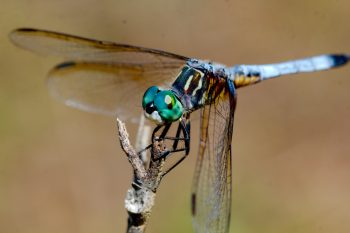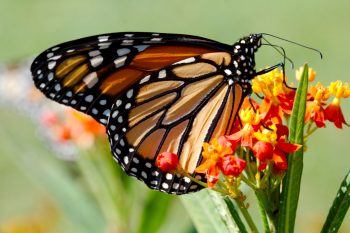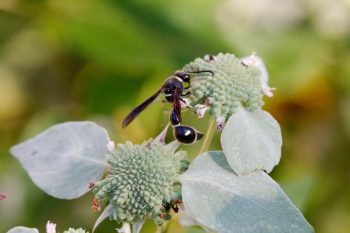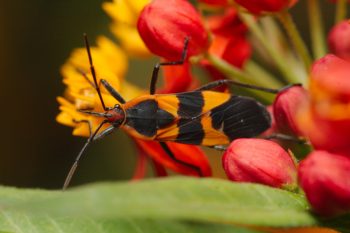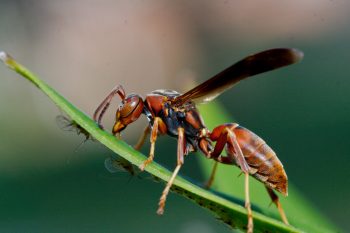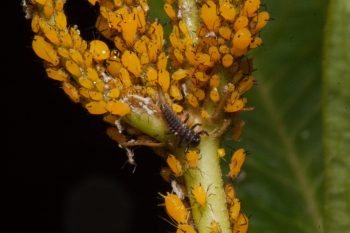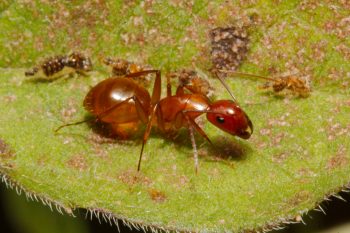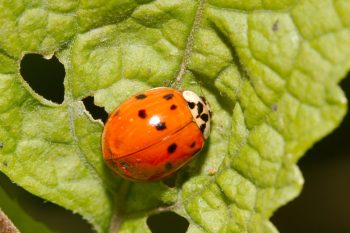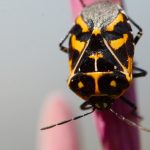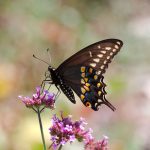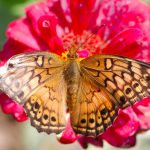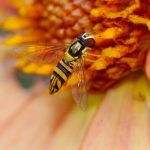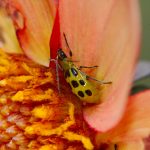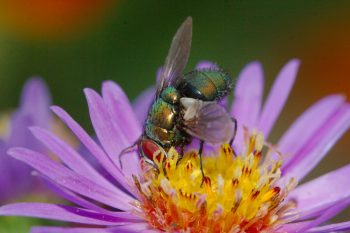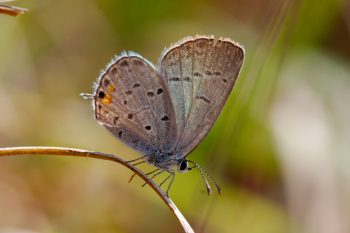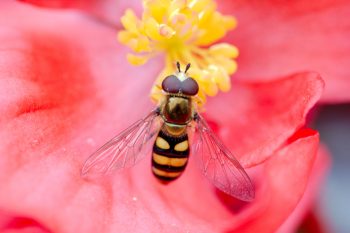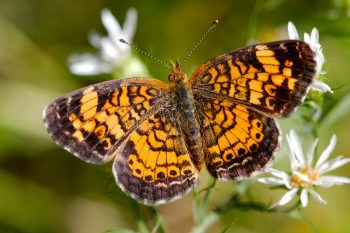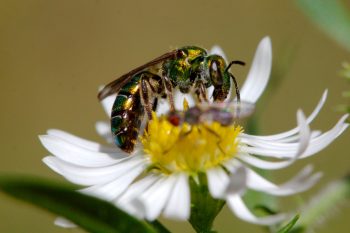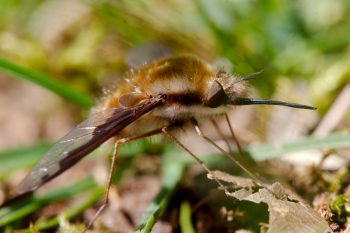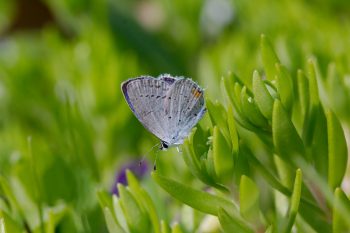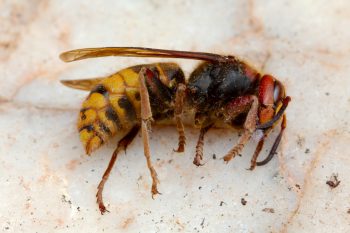I’ve been meaning to get out of the office for a short walk to the empty lot next to my building for over a week now. The upper part, where it was mostly mugwort, milkweed, and goldenrod has been mowed and it looks very different. I don’t know if this is a prelude to actual building plans coming to fruition. Plans to develop it started at least 25 years ago and the top soil was scraped up into a large mound that now has mid-size trees on it. There are a few drainage ponds and they are all abuzz with insects and birds. I saw a green heron when I first got there and then photographed a few dragonflies, including this blue dasher (Pachydiplax longipennis).
Tagged With: Insecta
Pachydiplax longipennis (Blue Dasher)
Danaus plexippus (Monarch)
The butterfly weed (Asclepias) growing in a container outside our back door is very attractive to insects but particularly so to monarchs (Danaus plexippus). Lately we’ve had two of them on it at once and occasionally three. I got a few pictures of the two today but I think this is a better portrait of this handsome butterfly. I really enjoyed sitting and watching them flutter around the flowers, stopping occasionally at other plants but generally preferring the butterfly weed.
Eumenes fraternus (Potter Wasp)
This potter wasp (Eumenes fraternus) is one of my favorite wasps (doesn’t everyone have favorite wasps?). There’s fairly common around here. While they are particularly drawn to the mountain mint (Pycnanthemum muticum), they are also found regularly on the black-eyed Susans (Rudbekia) and painter’s palette (a.k.a. knotweed, Persicaria virginiana). I think it’s their clean lines that I like. They’re difficult to photograph well and I’m not really happy with this photo, although it’s the best I was able to get. They don’t really stop moving and unless the light is very strong, it’s hard to get both adequate depth of field and a short enough exposure to stop their motion.
Oncopeltus fasciatus (Large Milkweed Bug)
It’s milkweed bug time in the garden. Cathy and I are both big fans of pretty much any species of Asclepias. This one is Asclepias curassavica, often known as scarlet milkweed. It’s growing in a container on our back patio and it really attracts the insects. I had a photo of a Monarch (Danaus plexippus) on it recently and today’s photo is of the aptly named large milkweed bug (Oncopeltus fasciatus). We also have a good colony of oleander aphids (Aphis nerii) and I may publish a photo of those, unless we get around to taking care of them before I do that. Like many insects that feed on milkweed, these bugs accumulate toxins from the plants which can “potentially sicken any predators foolish enough to ignore the bright colors which warn of their toxicity.” (bugguide.net)
Paper Wasp
There are a few paper wasps that are very difficult to distinguish and some that are impossible without examining them at the microscopic level. A number of them are quite variable, as well, adding to the difficulty. I think this is a northern paper wasp (Polistes fuscatus) but I’m nowhere near sure. It’s a beautiful creature, whatever it is. This was taken with my 100mm lens with the addition of a 25mm extension tube in bright evening sunlight. As you can see, I was able to get fairly close and I’m pleased by how sharp this turned out. You might also notice the aphids on the underside of the leaf the wasp is on. I took some photos of those, as well, but haven’t identified them yet (beyond the generic “aphid”).
Aphids and Lady Beetle Larva
I mentioned the aphids on the Asclepias curassavica (scarlet milkweed) when I posted the photo of the large milkweed bug a few days ago. Here’s a picture of the aphids. It was fairly dark when I took this (7:45 in the evening) and I used a flash to light them, which allowed me to get reasonable depth of field. I used a flashlight give me enough light to focus, with the camera on a tripod (which I definitely should use more often). As I was taking the pictures, I realized the aphids were not alone. There is a larva of a lady beetle of some sort (probably an Asian lady beetle, Harmonia axyridis), feeding on the aphids. Unfortunately, there are too many aphids for this lone predator, and I’m going to need to take care of them myself.
Cosmopepla lintneriana (Twice-stabbed Stink Bug)
I was out photographing flowers this evening. The light was fading and I didn’t think I could realistically get any photos of bees, wasps, or other flying insects. I was down on the ground to get some pictures of obedient plant, Physostegia virginiana, and I happened to notice this little fellow. I went in and got my flash, so I could get pictures that were worth something and I’m pretty happy with the results. This little bug (a true bug in the Heteroptera suborder) is only two or three millimeters long and if I hadn’t been down on the ground and very close, I never would have seen it. It is a twice-stabbed stink bug, Cosmopepla lintneriana. This one happens to be a nymph (an immature) and when adult will be mostly black with two red patches (the two “stab” marks of its common name).
Bombus impatiens (Common Eastern Bumble Bee)
Who doesn’t love the humble bumble bee? They are everywhere and like many of us, they are not particularly flashy or flamboyant. Nevertheless, they busily go about their business. I like them quite a bit and enjoy watching them move from flower to flower. In this case, a common eastern bumble bee (Bombus impatiens) is on wingstem, also known as yellow ironweed (Verbesina alternifolia). There were also honey bees (Apis mellifera) and ailanthus webworm moths (Atteva aurea) on the same group of flowers. It had become quite hot again, with temperatures in the low 90s, and I’m starting to look forward to autumn.
Carpenter Ant (Camponotus castaneus)
I came across this carpenter ant (Camponotus castaneus) in the yard today. I wasn’t sure I’d be able to get an identification on this ant. BugGuide.net says, about carpenter ants (Genus Camponotus), “This is one of the most species-rich ant genera, with perhaps 1000 species World-wide.” Nevertheless, it was identified. These are pests, of course, if they get into structures or valuable trees but they are fairly ubiquitous on almost the entire globe (only excluding the polar regions). They’re pretty things, like most insects, however.
Harmonia axyridis (Asian Lady Beetle)
This is the “many-named ladybird”. It has been called ‘multicolored’ (or ‘multicoloured’ in Britain), ‘multivariate’, ‘southern’, ‘Japanese’, ‘Asian’, ‘Halloween’, ‘harlequin’ and ‘pumpkin’ ladybird/ladybug/ladybeetle. I’m going with the simple ‘Asian’ and sticking to beetle, because it’s in the order Coleoptera. It’s a largish lady beetle and this particular species is immensely variable. The “standard” is red to red-orange with 18 spots, but as you can see, this one only has 12 (six on each side). The background ranges from a slightly orangy yellow to red and there are even versions with red spots on a black background.
Insects
I went on a short outing this afternoon to the Agricultural Farm Park today and spent a little time wandering around the Master Gardener’s display garden. Mostly I photographed insects (and a few flowers). It was a pretty productive outing as far as insect photos go.
- Danaus plexippus (Monarch) Caterpillar
- Murgantia histrionica (Harlequin Bug)
- Papilio polyxenes asterius (Black Swallowtail)
- Euptoieta claudia (Variegated Fritillary)
- Allograpta obliqua (Common Oblique Syrphid)
- Diabrotica undecimpunctata (Spotted Cucumber Beetle)
I’m particularly happy with the oblique syrphid fly, as that’s the first one I’ve photographed. The black swallowtail is one we don’t see nearly as often as the eastern tiger swallowtail. I’ve seen harlequin bugs on occasion but not all that often. The same is true of the cucumber beetle.
Stink Bug
I happened to look out my window this afternoon and saw this stink bug on the outside of the glass. Actually, it’s not unusual to see them inside the building. My guess is that this is a brown marmorated stink bug (Halyomorpha halys) but I’m not entirely sure and I’m not going to bother looking harder at it. The banded antennae are distinctive, along with the mottled color, but again, that’s just a guess and it’s good enough for me. I also took some pictures this evening of a hardy begonia that’s growing outside our front door. Those are probably prettier than this, being pink and yellow instead of tan (and buggy). But they weren’t as good as I’d like and I can always try to get better pictures, when the light is a bit stronger.
Blow Fly
I took pictures of insects on aster flowers this evening. There was a bumble bee covered with little white dots that I’m pretty sure were eggs of some kind and didn’t bode well for the little critter. There was also a beautiful, metallic green, sweat bee (family Halictidae) and I got a picture of it as it lifted off the flower, which would have been amazing if it had been in better focus. The light was relatively low and I was using a flash with a white reflector for these pictures, which helped considerably. I also had a 25mm extension tube behind my 100mm macro lens, which helped me get that much closer.
Cupido comyntas (Eastern Tailed-Blue)
I went outside today and walked around a bit in the lot next to my office. The weather was fine and it was nice to be out in the sunshine. I startled a belted kingfisher (Megaceryle alcyon) as I walked towards a vernal drainage pond. It’s often completely dry by this time of year but it had more water in it than in previous years and it hasn’t all evaporated yet. Above it, I was able to get close enough to get a pretty good photograph of this eastern tailed-blue (Cupido comyntas). They are pretty common but easily missed, as they are fairly small and flit around near the ground. They’re worth looking out for, I think.
Eupeodes americanus (American Hover Fly)
Cathy and I worked in the yard this afternoon. As I’ve mentioned before, there’s a lot to be done in the yard but I think we’ve made progress, at least. I took a break and took some pictures in the back yard. There are some bracket fungi on the ground above where there used to be a silver maple. They come up every year as the roots rot. I also took some pictures of some butterflies on the flowers around the patio. Then I saw this American hover fly (Eupeodes americanus) on the begonias growing in a pot on the patio. I was able to get some pretty decent photos of it as it moved from flower to flower.
Phyciodes tharos (Pearl Crescent)
I sent outside for a little while today and took some pictures of butterflies. I was down near the storm management pond next to my building and saw pearl crescents (Phyciodes tharos) as seen here as well as cabbage whites (Pieris rapae). There were also bees around, but not so many as there were only a few weeks ago. Getting good photographs of butterflies is challenging but it’s something I enjoy. This is a mid-sized butterfly, considerably smaller than the swallowtails or monarch but larger then the blue, featured recently. They are fairly common and easily spotted but as with most butterflies, difficult to get too close to.
Sweat Bee
I met Cathy outside for a little while early this afternoon. As we were walking back towards the entrance to my building we saw a white-tailed deer (Odocoileus virginianus) near the parking lot and I was able to get a few nice photographs of her. Cathy went back to her office and I went down near the pond and took some photos of insects. There was a type of fly that I hadn’t seen before. I thought it was a thick-headed fly (Family Conopidae) but it was identified as a Dioprosopa clavata, a syrphid fly (Family Halictidae) that resembles a thick-headed fly. Today’s photo, however, is of this metalic green sweat bee, a female in the genus Augochlorella.
Bombylius major (Greater Bee Fly)
I went out to take pictures last this morning, taking a short break from work. I had expected to take pictures of flowers of one sort or another but I happened to see this greater bee fly (Bombylius major) and was able to get pretty close to it and got a reasonable photo. It’s a fairly distinctive looking fly, with a hairy body. Differentiating flies from bees is generally easy if you can count their wings. The order Diptera, which is the flies, is so named because they have two wings (i.e. a single pair) instead of the normal insect wing count of four (two pairs).
Eastern Tailed-Blue (Cupido comyntas)
You can pretty much be sure that if there are things blooming, there are at least a few insects about. Insects aren’t the only pollinators, of course but they do the lion’s share of the work. Nevertheless, they are not out in numbers that we’ll see later in the year. I saw and photographed two different insects today. This one is an eastern tailed-blue (Cupido comyntas) and the other was a syrphid flies (Syrphidae, probably Toxomerus geminatus). So, the insect season is getting underway.
Vespa crabro (European Hornet)
This is a European hornet (Vespa crabro). It’s also dead. I found it on the floor of the basement when I stepped on it in my bare feet, which worried me a little. It was mostly dead before I stepped on it and completely dead after that. Since I didn’t get stung, I’m over it. They are predatory on other insects so in general (and outside my basement), I have no problem with them being around. They are similar in size to the eastern cicada killer (Sphecius speciosus) but are quite different in appearance. As large as they are, the European hornet is smaller than the Asian giant hornet (Vespa mandarinia, sometimes referred to as murder hornets), which can be 30% to 50% larger.

